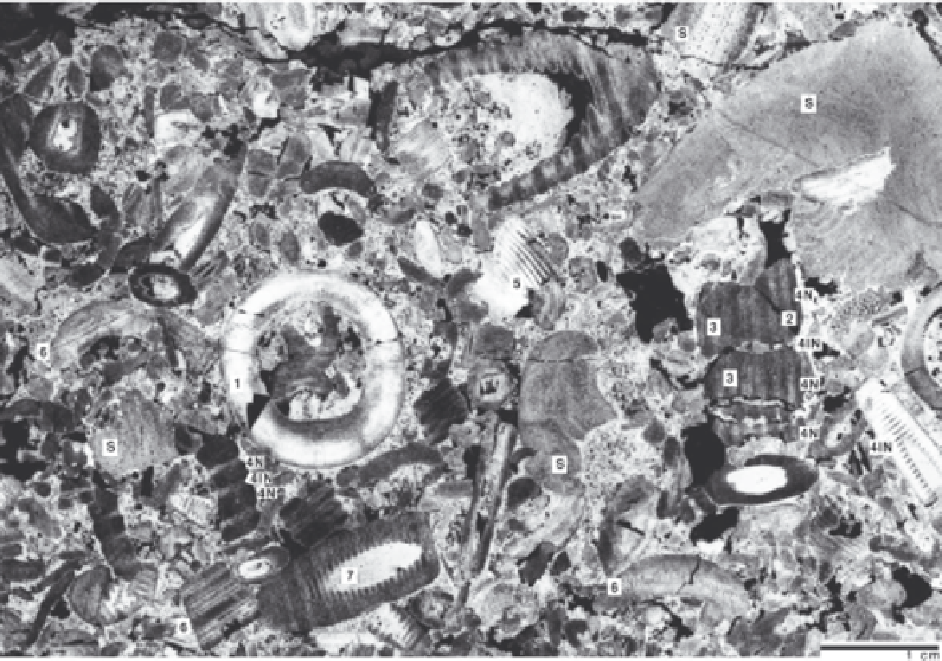Geology Reference
In-Depth Information
Fig. 10.55.
Crinoid limestone.
Most authors avoid a more detailed morphologic differentiation of disarticulated elements of
benthic crinoids in thin sections. However, the differentiation of dissociated crinoid elements (Moore and Jeffords 1968) in
washed samples and thin sections can assist in answering both stratigraphic and sedimentological problems (Stukalina 1988;
Ures et al. 1999).
The thin section exhibits several morphological features important for the taxonomic differentiation of dissociated parts
of crinoid stems. (1) Columnals: Individual components of the crinoid stalk. (2) Pluricolumnals: Two or more columnals
attached to each other. (3) Latera: Outer surface of crinoid columnals with variously shaped profiles. (4N) and (4IN): Nodals
and internodals: Larger and intercalated smaller columnals of a crinoid stalk. (5) Articula: Smooth or sculptured surface of
columnals serving for articulation with contiguous stem element. (6) Sutures of columnal articulation: Externally visible
edges of articula. (7) Axial canals: Longitudinal passageway penetrating the columnals, varying in transverse shape and
median longitudinal sections; complex axial canals are characterized by successive alternating columnal restrictions and
intercolumnal expansion.
This sediment was deposited adjacent to biostromal stromatoporoid-coral reefs. Crinoids lived at the flanks of the reefs.
The very poor sorting of crinoid fragments associated with well-preserved crinoid columnals indicates burial in quiet-water
settings without longer transport. Large angular stromatoporoid fragments (S) were admixed with the echinoderm detritus.
Late Silurian (Hoburgen limestone, Hamra/Sundre Beds, Ludlowian): Grötlinbo quarry, Hoburgen, Gotland Island, Sweden.
1994; Pl. 119/2) and also in slope environments
(Michalik et al. 1993). Parautochthonous crinoid accu-
mulations were formed in Silurian and Devonian fore-
reef areas. Crinoids were major contributors to the pio-
neer stage of Paleozoic reefs (see Sect. 16.2.6.2). An-
other type of autochthonous deposits are regionally ex-
tended accumulations of crinoids ('regional encrinites';
Ausich 1997).
bryozoan facies behind autochthonous accumulations
in mud mounds), on platforms, slopes, basins as well
as on seamounts. Deposition in subtidal environments
is frequently connected with storm-induced transport
of crinoid elements contributing to tempestites (Aigner
1984, 1985; Pl. 95/2). Slope and basinal setting of
crinoid accumulations may be associated with a down-
ward transport of crinoids from shallow or upper slope
environments leading to the formation of crinoidal tur-
bidites (Tucker 1969; Pl. 139/3). An upslope transport
of off-reef crinoids owing to the fact that crinoids can
Allochthonous deposits
formed on subtidal ramps
(e.g. in the Early Carboniferous Waulsortian crinoid-

